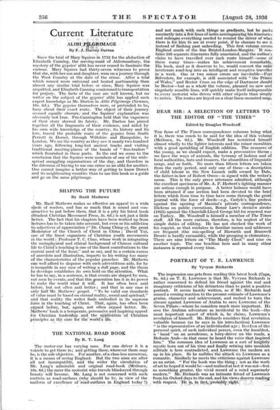THE NATIONAL ROAD 'BOOK
By R. T. Lang
The :motor-ear has varying uses. • For .one-driver it is a -chicle to get there in; and getting there, wherever there,may be, is the sole objective. For another, of a class less numerous, leis a means of seeing England. But the two aims are after all not " incompatible, and the wider the circulation of Mr. Lang's admirable and original road-book (Methuen, 10s. 6cL) the rarer the motorist who travels blind.eyed through beauty will become. Mr. Lang is not concerned with such matters as road-surfaces (why should he be, in view of the uniform of excellence of -road-surfaees in England today ?) and not much with such things as gradients, put he packs succinctly into lines of notes accompanying his itineraries . and mileages!everything needed to remind the driver of what there is for, him to see at every point, if he chooses to see it instead of flashing past This first volume covers England south of the line Bristol-ondon-Margate: 'it -con- tains 336 separate itineraries fully annotated, and the author's claim to have travelled over each route himself—some of them many times--'-makes his Uchievethent remarkable4:, His book, used as it deserves to be, would convert the nfttst' inveterate road-hog into an intelligent and receptive traveller in' a week. One or two minor: errors are inevitable—Fort Belvedere, for example, is still associated with " the Prince of 'Wales," and Bector Cross on the edge of Dartmoor should
Beetor—btit as a whole the volume, planned On: and singularly sensible lines, will quickly make Itself indispensable to ;every motorist who drives with other objects than simply to arrive. The routes are keyed on a clear linen-mounted map,.






































 Previous page
Previous page